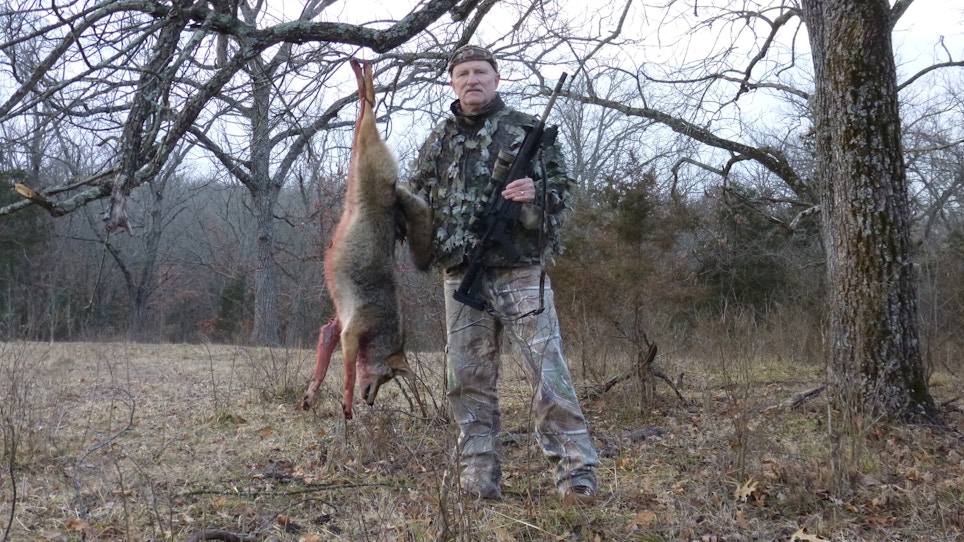 Alex Wiggs | Missouri
Alex Wiggs | Missouri
It was a crisp October morning and I had arrived just before first light at one of my favorite coyote hunting areas here in the beautiful Ozarks of Missouri. After about 40 minutes of calling on stand I was about to call it quits when a group of crows arrived on the scene making a noisy fuss trying to run a hawk out of the area. As I happened to look to my left, a coyote came running to the scene apparently to see what all the commotion was about. Although I never got the opportunity to take a shot, I learned the valuable lesson that coyotes will respond to more than distress calls and even howls. With the popularity of predator hunting on the rise across the nation and more and more competition from fellow predator hunters, in order to put more fur in the back of our trucks, we predator hunters need to have more than our “lucky” rabbit distress in our predator calling arsenal.
How many times have we given up on a set that appeared to be over without wishing we had one last calling technique to try before moving on to the next area? Many times coyotes are called in to a set and for whatever reason do not show themselves. I believe that the majority of calling sets result in a predator responding to your call, but not exposing itself for one of several reasons. One reason might be that it doesn't see the animal making the distress call or maybe it is reluctant to show itself for fear of being run off by a dominant coyote in the area. I have learned that a flurry of commotion carefully orchestrated by the predator hunter to sound like a meal that is about to be carried off by another predator works well to coax out a timid or “hung up” coyote. Additionally, an educated coyote will be much tougher to fool, but this “making a ruckus” technique is something that they have likely never heard before. Of course no calling technique works every time, but “making a ruckus” before you give up on a set is worth a try.
The first coyote I killed three years ago with my Rock River Arms Elite Operator (.308 caliber), I killed using this method. I was just about to give up when I decided to try imitating a fight between two coyotes over the rabbit distress sound that I was playing on my FOXPRO. I started with a coyote bark then gave a quick hurt coyote yelp and followed both calls up with a crow frenzy. My reasoning was that a coyote might be watching in the edge of the wood line, but wasn't quite ready to commit to coming out into the open and just might respond to all the “ruckus.” The result was a rather large male coyote that came running out in the open.
Recently, as I sat listening to my FOXPRO cranking out a mournful jackrabbit distress, a group of crows arrived on the scene and were going crazy overhead squawking at the sound of my call and dive bombing a Montana Decoy's Miss Hoptober rabbit decoy I had set up out in the field 50 yards in front of me. About a minute more into the calling sequence, two hawks arrived and landed in the same tree I was leaning against and started their own loud screeching noise. The crows and the hawks kept this up for over three minutes. Since I record all my hunting trips on video, I ended up with a recording of a jackrabbit distress/authentic crow frenzy/authentic screeching hawk calling sequence! I didn't realize what I had until I got home and started to download the video of my hunt. I stripped the audio off the recording using an online audio extractor program and uploaded it to my FOXPRO. Now I have a very effective, authentic “ruckus” call that I use regularly in my coyote hunting. Creative thinking like this I believe will put more coyote hides on the stretcher.
To make this “ruckus” using mouth calls, you will need a couple of calls that will do a coyote bark, a pup distress and a crow call. At the end of your calling sequence when you are ready to move on to the next area — right at the end of your last distress call — do a mock fight between two coyotes by doing a quick coyote bark followed by a pup distress (injured coyote) sound. Repeat this once or twice with a crow calling frenzy in the middle of the mock coyote fight and then go silent for about two minutes, keeping a sharp look out for a coyote responding. Repeat the entire sequence and go silent for another two minutes. If the coyote is going to come in, it usually comes in quickly so you will need to be ready for a quick shot.
There you have it. Instead of giving up on a set, and possibly educating a reluctant coyote that has been observing your calling efforts just out of sight, give this technique a try. To take more fur home, we predator hunters have to be more and more creative and not be afraid to try new techniques. Don't forget to “make a ruckus” before you throw in the towel on your next coyote hunting set. Good hunting!
Alex Wiggs is a retired electronics technician whose passion is predator hunting in the Ozarks of Missouri and capturing his hunts on videography equipment of his own design, namely, the Video ‘No-Shok’ Xtreme. Check out his YouTube channel for more details at: https://www.youtube.com/watch?v=kRAqfWrzKUI






